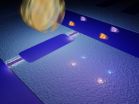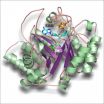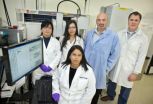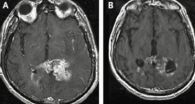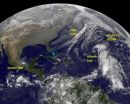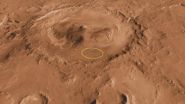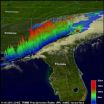(Press-News.org) Scientists at Chalmers University of Technology have succeeded in creating light from vacuum – observing an effect first predicted over 40 years ago. The results is published tomorrow (Wednesday) in the journal Nature. In an innovative experiment, the scientists have managed to capture some of the photons that are constantly appearing and disappearing in the vacuum.
The experiment is based on one of the most counterintuitive, yet, one of the most important principles in quantum mechanics: that vacuum is by no means empty nothingness. In fact, the vacuum is full of various particles that are continuously fluctuating in and out of existence. They appear, exist for a brief moment and then disappear again. Since their existence is so fleeting, they are usually referred to as virtual particles.
Chalmers scientist, Christopher Wilson and his co-workers have succeeded in getting photons to leave their virtual state and become real photons, i.e. measurable light. The physicist Moore predicted way back in 1970 that this should happen if the virtual photons are allowed to bounce off a mirror that is moving at a speed that is almost as high as the speed of light. The phenomenon, known as the dynamical Casimir effect, has now been observed for the first time in a brilliant experiment conducted by the Chalmers scientists.
"Since it's not possible to get a mirror to move fast enough, we've developed another method for achieving the same effect," explains Per Delsing, Professor of Experimental Physics at Chalmers. "Instead of varying the physical distance to a mirror, we've varied the electrical distance to an electrical short circuit that acts as a mirror for microwaves.
The "mirror" consists of a quantum electronic component referred to as a SQUID (Superconducting quantum interference device), which is extremely sensitive to magnetic fields. By changing the direction of the magnetic field several billions of times a second the scientists were able to make the "mirror" vibrate at a speed of up to 25 percent of the speed of light.
"The result was that photons appeared in pairs from the vacuum, which we were able to measure in the form of microwave radiation," says Per Delsing. "We were also able to establish that the radiation had precisely the same properties that quantum theory says it should have when photons appear in pairs in this way."
What happens during the experiment is that the "mirror" transfers some of its kinetic energy to virtual photons, which helps them to materialise. According to quantum mechanics, there are many different types of virtual particles in vacuum, as mentioned earlier. Göran Johansson, Associate Professor of Theoretical Physics, explains that the reason why photons appear in the experiment is that they lack mass.
"Relatively little energy is therefore required in order to excite them out of their virtual state. In principle, one could also create other particles from vacuum, such as electrons or protons, but that would require a lot more energy."
The scientists find the photons that appear in pairs in the experiment interesting to study in closer detail. They can perhaps be of use in the research field of quantum information, which includes the development of quantum computers.
However, the main value of the experiment is that it increases our understanding of basic physical concepts, such as vacuum fluctuations – the constant appearance and disappearance of virtual particles in vacuum. It is believed that vacuum fluctuations may have a connection with "dark energy" which drives the accelerated expansion of the universe. The discovery of this acceleration was recognised this year with the awarding of the Nobel Prize in Physics.
INFORMATION:
Full bibliographic information: "Observation of the dynamical Casimir effect in a superconducting circuit", C. M. Wilson, G. Johansson, A. Pourkabirian, M. Simoen, J. R. Johansson, T. Duty, F. Nori, & P. Delsing, Nature 479, 376 (17 November 2011), doi:10.1038/nature10561
Chalmers scientists create light from vacuum
Scientists at Chalmers University of Technology have succeeded in creating light from vacuum
2011-11-21
ELSE PRESS RELEASES FROM THIS DATE:
Enzymatic synthesis of pyrrolysine, the mysterious 22nd amino acid
2011-11-21
This press release is available in German.
With few exceptions, all known proteins are built up from only twenty amino acids. 25 years ago scientists discovered a 21st amino acid, selenocysteine and ten years ago a 22nd, the pyrrolysine. However, how the cell produces the unusual building block remained a mystery. Now researchers at the Technische Universitaet Muenchen have elucidated the structure of an important enzyme in the production of pyrrolysine. The scientific journal Angewandte Chemie reports on their results in its "Early View" online section.
Proteins ...
MU researchers develop tool that saves time, eliminates mistakes in diabetes care
2011-11-21
COLUMBIA, Mo. – In the fast-paced world of health care, doctors are often pressed for time during patient visits. Researchers at the University of Missouri developed a tool that allows doctors to view electronic information about patients' health conditions related to diabetes on a single computer screen. A new study shows that this tool, the diabetes dashboard, saves time, improves accuracy and enhances patient care.
The diabetes dashboard provides information about patients' vital signs, health conditions, current medications, and laboratory tests that may need to be ...
Colon cancer screening campaign erases racial, gender gaps in use of colonoscopy
2011-11-21
Since the 1970s, U.S. mortality rates due to colorectal cancer have declined overall, yet among blacks and Hispanics, the death rates rose. Evidence suggests that underuse of colonoscopy screening among these groups is one reason for the large disparities. In 2003, New York City launched a multifaceted campaign to improve colonoscopy rates among racial and ethnic minorities and women. A new study conducted by researchers at Columbia University's Mailman School of Public Health and the NYC Department of Health and Mental Hygiene demonstrates the notable success of the campaign. ...
A corny turn for biofuels from switchgrass
2011-11-21
Many experts believe that advanced biofuels made from cellulosic biomass are the most promising alternative to petroleum-based liquid fuels for a renewable, clean, green, domestic source of transportation energy. Nature, however, does not make it easy. Unlike the starch sugars in grains, the complex polysaccharides in the cellulose of plant cell walls are locked within a tough woody material called lignin. For advanced biofuels to be economically competitive, scientists must find inexpensive ways to release these polysaccharides from their bindings and reduce them to fermentable ...
Great Plains river basins threatened by pumping of aquifers
2011-11-21
CORVALLIS, Ore. – Suitable habitat for native fishes in many Great Plains streams has been significantly reduced by the pumping of groundwater from the High Plains aquifer – and scientists analyzing the water loss say ecological futures for these fishes are "bleak."
Results of their study have been published in the journal Ecohydrology.
Unlike alluvial aquifers, which can be replenished seasonally with rain and snow, these regional aquifers were filled by melting glaciers during the last Ice Age, the researchers say. When that water is gone, it won't come back – at ...
Old drugs find new target for treating brain tumor
2011-11-21
Scientists at the University of California, San Diego School of Medicine and UC San Diego Moores Cancer Center, in collaboration with colleagues in Boston and South Korea, say they have identified a novel gene mutation that causes at least one form of glioblastoma (GBM), the most common type of malignant brain tumor.
The findings are reported in the online edition of the journal Cancer Research.
Perhaps more importantly, the researchers found that two drugs already being used to treat other forms of cancer effectively prolonged the survival of mice modeling this particular ...
GOES satellite eyeing late season lows for tropical development
2011-11-21
Its late in the Atlantic and eastern Pacific hurricane seasons, but the calendar isn't stopping the tropics. The GOES-13 satellite is keeping forecasters informed about developing lows like System 90E in the eastern Pacific and another low pressure area in the Atlantic.
System 90E and the Atlantic low pressure area were both captured in one image from the NOAA's GOES-13 satellite today, November 18, 2011 at 1145 UTC (7:45 a.m. EST). The image was created by the NASA GOES Project (in partnership with NOAA) at NASA's Goddard Space Flight Center in Greenbelt, Maryland.
The ...
New NASA missions to investigate how Mars turned hostile
2011-11-21
Maybe because it appears as a speck of blood in the sky, the planet Mars was named after the Roman god of war. From the point of view of life as we know it, that's appropriate. The Martian surface is incredibly hostile for life. The Red Planet's thin atmosphere does little to shield the ground against radiation from the Sun and space. Harsh chemicals, like hydrogen peroxide, permeate the soil. Liquid water, a necessity for life, can't exist for very long here --any that does not quickly evaporate in the diffuse air will soon freeze out in subzero temperatures common over ...
Walking through doorways causes forgetting, new research shows
2011-11-21
We've all experienced it: The frustration of entering a room and forgetting what we were going to do. Or get. Or find.
New research from University of Notre Dame Psychology Professor Gabriel Radvansky suggests that passing through doorways is the cause of these memory lapses.
"Entering or exiting through a doorway serves as an 'event boundary' in the mind, which separates episodes of activity and files them away," Radvansky explains.
"Recalling the decision or activity that was made in a different room is difficult because it has been compartmentalized."
The study ...
NASA's TRMM satellite sees deadly tornadic thunderstorms in Southeastern US
2011-11-21
Tornadoes are expected to accompany severe storms in the springtime in the U.S., but this time of year they also usually happen. When a line of severe thunderstorms associated with a cold front swept through the U.S. southeast on Nov. 16, TRMM collected rainfall data on the dangerous storms from space.
NASA's Tropical Rainfall Measuring Mission (TRMM) satellite flew over the southeastern United States on November 16, 2011 at 2310 UTC (6:10 p.m. EST) when tornadoes were occurring with a line of thunderstorms that stretched from western Florida north through North Carolina. ...
LAST 30 PRESS RELEASES:
Germline pathogenic variants among women without a history of breast cancer
Tanning beds triple melanoma risk, potentially causing broad DNA damage
Unique bond identified as key to viral infection speed
Indoor tanning makes youthful skin much older on a genetic level
Mouse model sheds new light on the causes and potential solutions to human GI problems linked to muscular dystrophy
The Journal of Nuclear Medicine ahead-of-print tip sheet: December 12, 2025
Smarter tools for peering into the microscopic world
Applications open for funding to conduct research in the Kinsey Institute archives
Global measure underestimates the severity of food insecurity
Child survivors of critical illness are missing out on timely follow up care
Risk-based vs annual breast cancer screening / the WISDOM randomized clinical trial
University of Toronto launches Electric Vehicle Innovation Ontario to accelerate advanced EV technologies and build Canada’s innovation advantage
Early relapse predicts poor outcomes in aggressive blood cancer
American College of Lifestyle Medicine applauds two CMS models aligned with lifestyle medicine practice and reimbursement
Clinical trial finds cannabis use not a barrier to quitting nicotine vaping
Supplemental nutrition assistance program policies and food insecurity
Switching immune cells to “night mode” could limit damage after a heart attack, study suggests
URI-based Global RIghts Project report spotlights continued troubling trends in worldwide inhumane treatment
Neutrophils are less aggressive at night, explaining why nighttime heart attacks cause less damage than daytime events
Menopausal hormone therapy may not pose breast cancer risk for women with BRCA mutations
Mobile health tool may improve quality of life for adolescent and young adult breast cancer survivors
Acupuncture may help improve perceived breast cancer-related cognitive difficulties over usual care
Nerve block may reduce opioid use in infants undergoing cleft palate surgery
CRISPR primes goldenberry for fruit bowl fame
Mass General Brigham announces new AI company to accelerate clinical trial screening and patient recruitment
Fat tissue around the heart may contribute to greater heart injury after a heart attack
Jeonbuk National University researcher proposes a proposing a two-stage decision-making framework of lithium governance in Latin America
Chromatin accessibility maps reveal how stem cells drive myelodysplastic progression
Cartilaginous cells regulate growth and blood vessel formation in bones
Plant hormone allows lifelong control of proteins in living animal for first time
[Press-News.org] Chalmers scientists create light from vacuumScientists at Chalmers University of Technology have succeeded in creating light from vacuum
